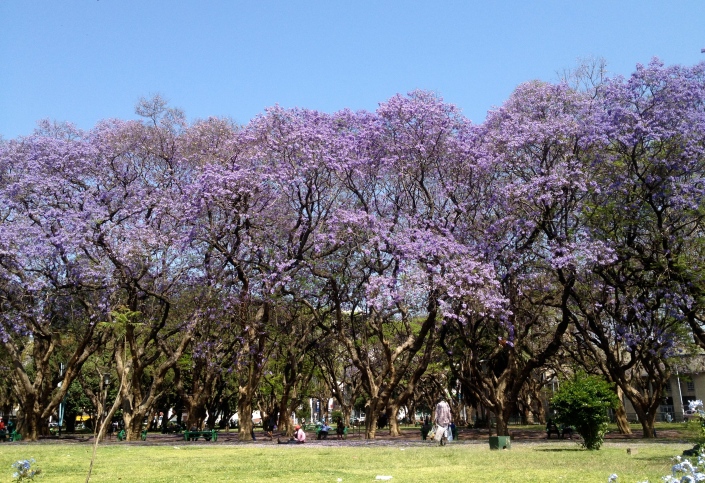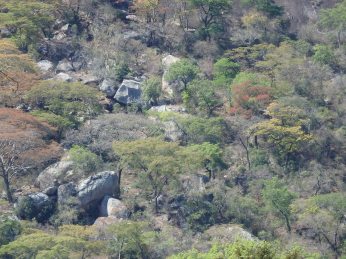 18th May 2015 – Header update: lovely though Harare’s jacaranda trees may look, I got bored with them as the header. I’m sticking with a Harare theme, and instead I’m using a section of the façade of the National Gallery of Zimbabwe, a beautiful modernist building that was opened in 1957. This blog post therefore relates to the previous headers.
18th May 2015 – Header update: lovely though Harare’s jacaranda trees may look, I got bored with them as the header. I’m sticking with a Harare theme, and instead I’m using a section of the façade of the National Gallery of Zimbabwe, a beautiful modernist building that was opened in 1957. This blog post therefore relates to the previous headers.
Some words relating to the two images currently used on the blog’s header: Harare’s Africa Unity Square, with a few of the many jacaranda trees in the Zimbabwean capital.
This pleasant garden is located in the heart of Harare’s central business district, in what surely must be one of the most relaxed (superficially at least) African capitals. The square is dominated by jacaranda trees, their interwoven branches serving as a protective canopy for flower-sellers, workers taking breaks from their offices and other passersby. For a few short weeks between late September and late October, lilac-coloured blossom adorns the trees, the shades gradually intensifying as the temperature rises, with the flowers eventually dropping to carpet the ground beneath.

Jacaranda trees are found all over Harare and Zimbabwe’s other towns and cities, as well as widely scattered across the countryside. People in Zimbabwe with whom I spoke said that they always look forward to the blossom which, apart from simply being pretty (Harare, while by no means ugly, is a rather drab place), is seen as marking the change of seasons – the end of the dry “winter” and the hope that “summer” rains will bring. Just as cherry blossom is a Japanese icon, so too is jacaranda an icon of Harare. Except jacaranda isn’t Zimbabwean. It’s an invader.
Jacaranda is in fact a “native” of South America, in particular of Brazil. The story goes that the plant was first introduced to Fort Salisbury – the future Harare – in 1899 by a honeymooning couple who carried home six seedlings from the botanical gardens in Durban, South Africa. Thanks to the power of public works projects in the early twentieth century, jacaranda trees soon took root in Salisbury’s parks, gardens and alongside its expanding road network. One of those places was Cecil Square, named for Cecil Rhodes, whose British South African Company took control of this part of central Africa in the 1890s and laid out in the form of a Union Jack flag. Following the end of white-minority rule and the transformation of Rhodesia to Zimbabwe, many of the colonial place names were changed, with Cecil Square taking the name Africa Unity Square.

In recent years, however, the position of jacaranda trees has been questioned. With the plant now classified as being an “invasive species”, Harare’s authorities are seeking to phase out the trees, and aim to replace them with plants indigenous to the native bushveld, the local sub-tropical woodland. The crime that this pretty, but apparently dangerous, tree has been committing is the aggressive stifling of native plant life of the kind that provides more favourable cover for indigenous fauna, in particular insects and birds.
For the time being jacaranda is being tolerated in Harare, but no new planting is permitted. Although the lifespan of a jacaranda tree is relatively short (100 years or so), its wind-blown seeds are good at self-propagation; without intervention, action may be needed to control their spread.
In reality, it’s hard to take too seriously the debate as to whether jacarandas should be permitted to remain a feature of Harare’s landscape.
Since European colonisers pushed their way northwards into this part of Africa in the late nineteenth century, the bushveld flora and fauna has been eliminated from vast swathes of land, in favour of cotton, cattle, sugar and, most of all tobacco. In the wake of the virtual collapse of agricultural production a decade or so ago following the violent and chaotic seizure of property from white commercial farmers, Zimbabwe surely has more pressing land-management issues than the elimination of a rather beautiful Brazilian weed. 

Great piece. I loved the jacaranda trees in Harare. I hope they stay, but – as you say – there are a lot more pressing things which need to be done.
LikeLike
Not that any of those more pressing needs are likely to be done any time soon…. Thanks, Richard, for your comment.
LikeLike